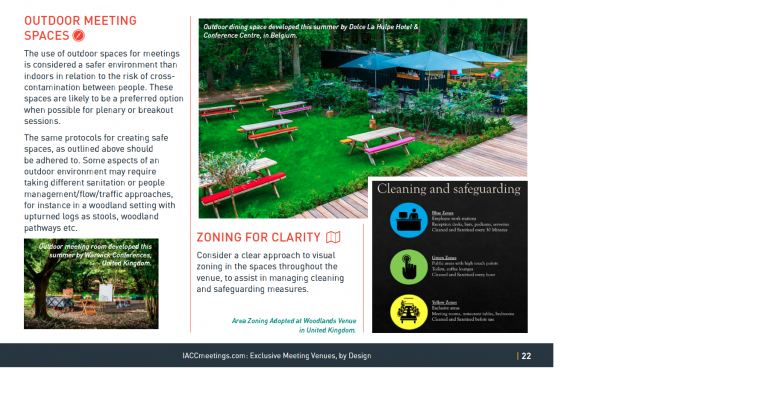The culmination of an effort that began only six weeks ago, IACC (formerly the International Association of Conference Centers) has released a detailed blueprint of protocols and tactics that meeting venues can use to ensure cleanliness and social distancing. The goal: Building confidence among planners that in-person meetings of up to 200 people can happen once local governments allow it.
Titled “Critical Pathway for Reopening Meeting, Conference, and Training Spaces,” the report comes with dozens of photos taken at several of IACC’s 400 member facilities to illustrate the concepts, tactics, and designs that are described. Mark Cooper, CEO of IACC, notes that besides getting input from experts in health and hygiene, “those who contributed to the content are generally senior leadership overseeing many venues, so the report draws on their knowledge, experiences, and perspectives. We had case studies from many members in the U.S., Canada, and Europe.” Aramark Conferencing, Benchmark Hospitality, and Sodexo Conferencing are among the largest facility-management firms that contributed.
The report covers attendees’ and presenters’ interactions with a venue’s indoor and outdoor spaces, venue staff, event-host staff, and each other from arrival through departure, starting with the possible ways to conduct health screenings at arrival and throughout an event’s duration. Various cleaning products and processes are covered, as are different types of set-ups for meeting spaces, prefunction spaces, covered and uncovered patios and courtyards, break and meal spaces, and lobby spaces. Safe yet streamlined traffic-flow patterns through and between spaces is also addressed. Lastly, the guide provides ideas on how venues can structure their pricing to account for the greater amount of square footage required per attendee.
Although the report is aimed at venue operators who can implement the various ideas, “whoever reads it will see the level of planning and preparedness our industry is going through to make meetings the safest form of bringing people back together for business,” says Cooper. “It shows how venues are developing their products and services to best support their clients’ changed needs. For event planners who read the guide, they should ask each venue they might use if it is showing the same level of professionalism and forward thinking in preparing for their particular meeting, training course, or conference.”
All IACC member properties receive the report for free, while the price for nonmembers is $199. It can be found here. However, Cooper notes that “while we did not anticipate that a venue will proactively share this guide with clients, there is no reason why a venue couldn’t show it to potential clients to demonstrate the information and guidance they used to create a comprehensive plan tailored to their venue.”





